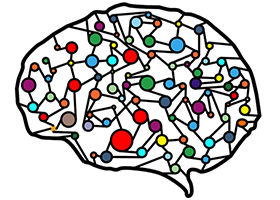Network Neuroscience: Brain Networks in the Field of Affective, Cognitive and Personality Neuroscience
A special issue of Brain Sciences (ISSN 2076-3425). This special issue belongs to the section "Computational Neuroscience, Neuroinformatics, and Neurocomputing".
Deadline for manuscript submissions: closed (10 April 2021) | Viewed by 26596

Special Issue Editors
Interests: affective and personality disorders; brain network; mathematical anxiety; applied neuroscience; neurofeedback
2. Department of Computer, Control, and Management Engineering Antonio Ruberti, Sapienza University of Rome, Piazzale Aldo Moro, 5, 00185 Rome, Italy
Interests: BCI; rehabilitation; mental states; emotional states; locked-in patients; cognitive engagement; cognitive processes
Special Issues, Collections and Topics in MDPI journals
Special Issue Information
Dear Colleagues,
In the last few years, network neuroscience has emerged as an interdisciplinary field of extensive research, aiming to understand the role of human brain networks during affective and cognitive processing, as in the explanation of more subtle phenotypic characteristics, like personality. Network neuroscience shifted our mind-set from unimodal (activation/deactivation of certain regions) to multimodal models (collaboration between different brain regions), which seem to be closer to the brain’s complexity. In the last years, this became even more meaningful, considering the increase of brain regions that can be simultaneously recorded either by different neuroimaging modalities like electroencephalography (EEG), magnetoencephalography (MEG) and functional magnetic resonance imaging (fMRI).
Despite the major advances in the field of network neuroscience, research on its application to increase our understanding of emotions and cognitive functioning, as well as in individual differences is still scarce. This is mainly due to the limitations of current computational approaches, as to their application in enough neuroimaging data (Big Data) to safely answer biologically inspired neuroscientific questions.
The current Special Issue will cover state-of-the-art research in network neuroscience focused on computational approaches, as well as on their applications in the fields of affective, cognitive, and personality neuroscience, using both neurophysiological (EEG, MEG, etc.) and neuroimaging (fMRI, DWI, etc.) modalities, with the main aim to expand our current knowledge and produce new theoretical frameworks.
Topics may include, but are not limited to, the following:
- Computational approaches in estimating the functional and/or structural connectivity
- Graph theoretical models in network neuroscience
- Multi-scale and multi-graph models of the human brain
- Brain Networks in the field of the affective/cognitive/personality neuroscience
- Brain networks in brain–computer interface-based applications
Dr. Manousos A. Klados
Prof. Dr. Ana Vivas
Dr. Pietro Aricò
Guest Editors
Manuscript Submission Information
Manuscripts should be submitted online at www.mdpi.com by registering and logging in to this website. Once you are registered, click here to go to the submission form. Manuscripts can be submitted until the deadline. All submissions that pass pre-check are peer-reviewed. Accepted papers will be published continuously in the journal (as soon as accepted) and will be listed together on the special issue website. Research articles, review articles as well as short communications are invited. For planned papers, a title and short abstract (about 250 words) can be sent to the Editorial Office for assessment.
Submitted manuscripts should not have been published previously, nor be under consideration for publication elsewhere (except conference proceedings papers). All manuscripts are thoroughly refereed through a single-blind peer-review process. A guide for authors and other relevant information for submission of manuscripts is available on the Instructions for Authors page. Brain Sciences is an international peer-reviewed open access monthly journal published by MDPI.
Please visit the Instructions for Authors page before submitting a manuscript. The Article Processing Charge (APC) for publication in this open access journal is 2200 CHF (Swiss Francs). Submitted papers should be well formatted and use good English. Authors may use MDPI's English editing service prior to publication or during author revisions.
Benefits of Publishing in a Special Issue
- Ease of navigation: Grouping papers by topic helps scholars navigate broad scope journals more efficiently.
- Greater discoverability: Special Issues support the reach and impact of scientific research. Articles in Special Issues are more discoverable and cited more frequently.
- Expansion of research network: Special Issues facilitate connections among authors, fostering scientific collaborations.
- External promotion: Articles in Special Issues are often promoted through the journal's social media, increasing their visibility.
- Reprint: MDPI Books provides the opportunity to republish successful Special Issues in book format, both online and in print.
Further information on MDPI's Special Issue policies can be found here.








